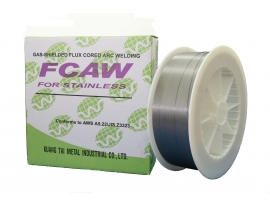



|
Applications and Features |
|
|||||||||||||
|
( 1 ) Weld metal is austenitic structure with 18% Cr-11.5% Ni-2.2Mo. ( 2 ) Exceelent resistance to general, pitting and intergranular corrosion due to Mo addition. ( 3 ) Stable arc, good slag removal, low spatters, X-ray quality welds and good penetration. ( 4 ) Suitable for welding critical chemical vessels and AISI 316L stainless steel. |
|
|||||||||||||
|
Welding position |
|
|||||||||||||
|
|
|
|||||||||||||
|
Welding Instruction |
|
|||||||||||||
|
( 1 ) For other instructions, please refer to Appendix D. ( 2 ) For extra information, please refer to Appendix F. |
|
|||||||||||||
|
Typical Chemical Composition of Weld Metal (wt%) |
|
|||||||||||||
|
C |
Si |
Mn |
P |
S |
Cr |
Ni |
Mo |
|||||||
|
0.02 |
0.53 |
0.93 |
0.021 |
0.011 |
17.75 |
11.41 |
2.22 |
|||||||
|
Typical Mechanical Properties of Weld Metal |
|
|||||||||||||
|
Tensile Strength N/mm2 |
Yield Strength N/mm2 |
Elongation % |
||||||||||||
|
574 |
411 |
37 |
||||||||||||
|
Size and Suggested Operating Range (DC+) |
|
|||||||||||||
|
Diameter (mm) |
0.9 |
1.2 |
1.6 |
|||||||||||
|
Current (A) |
Flat/H-fillet |
110~150 |
150~220 |
200~300A |
||||||||||
|
V-up |
100~130 |
130~160 |
150~180A |
|||||||||||






